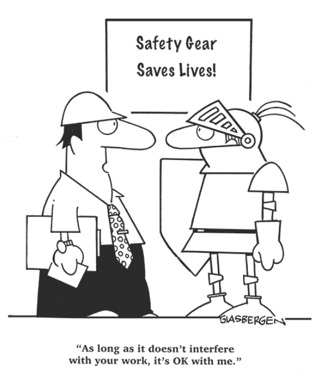 Most Factories and Manufacturing industries make it mandatory for any worker, supervisor, or employee on duty to record any case of near misses. This is because near misses are simply accidents in which no personal injury was sustained but where a delicate change in time, position, or place could have led to a severe injury or even death in some cases. Employees need to report near misses because they help to prevent an accident due to the same reasons in the future.
Most Factories and Manufacturing industries make it mandatory for any worker, supervisor, or employee on duty to record any case of near misses. This is because near misses are simply accidents in which no personal injury was sustained but where a delicate change in time, position, or place could have led to a severe injury or even death in some cases. Employees need to report near misses because they help to prevent an accident due to the same reasons in the future.
Near misses and many other similar incidents make up the components of an incident report. So, an incident report is essentially a way of informing any superior or anyone in an organization or facility of the various incidents that make up the entire working experience of employees at a facility.
In this article, we discuss incident reports, the benefits, why it’s crucial for the hospitality industry as much as it is for the manufacturing industry to use them.
An Overview of an Incidence Report
Law Insider describes an incident report as a factual written statement about a certain event detailing the components of the incident, such as the date, time, location, the persons involved, including their functional titles, and the cause and effect of the event as injuries. An incident report typically contains details of the witnesses to an incident.
IncidentReport.net describes incident reporting as the process of capturing, recording, and managing the occurrence of an incident, such as injury, property damage, security breach, or safety hazards.
However, a simple definition is an incident report details how, when, and where an incident occurred with reference to the people involved and those that witnessed such an incident.

An incident report can be recorded digitally using computing power or traditionally, using a pen, paper, printer, and other similar tools.
Some of the events captured in an incident report include: Injuries, Accidents, Near Misses, Property and Equipment Damage, Security Breach, Health and Safety Hazards, Workplace Misconduct, Hotel Service Misconduct, Harassment.
Why Does Your Organization Need an Incident Report?

According to the World Health Organization (WHO), work-related accidents and diseases lead to approximately 2.8 million deaths globally each year. This translates to about 7,700 deaths daily. Additionally, it is estimated that there are around 374 million non-fatal work-related injuries annually. These incidents have a significant human and economic impact, contributing to a substantial burden on global health systems.
Incident reports play a critical role in identifying the causes of these work-related accidents and illnesses, helping to develop effective strategies to prevent them.
In a less dramatic illustration, hotels and other organizations in the hospitality industry need incident reporting to help in the investigation and analysis of an event. For instance, how do you know how to improve your customer service and other areas that need improvement if you do not understand how they are failing in the first place?
The three categories of people that can use an incident report include:
1. A person with authority who can implement changes with the details obtained from an incident report.
2. An employee, to help report an incident or learn from the details of a prior incident to avoid making the same mistakes in the future.
3. Any member of an organization that needs to raise awareness about an incident that occurred in the facility or outside it related to work.
Note: It is essential for an incident report to be filed at the time of the incident, no matter how minor an incident or injury is.
What is an Incident?
The biggest question from managers or employees looking to implement an incident report for the first time is usually, what counts as an incident?
An incident is any event, operation, condition, or situation that:
- - Disrupts the activities of a facility or organization
- - Poses a significant risk to any member of an organization
- - Significantly impacts the systems, operation, and assets of an organization negatively
- - Impacts the reputation of an organization or its workers negatively in the media or to the customers.
The Benefits of an Incident Report
 The benefits of incident reports are pretty straightforward. The more detailed and frequently your incident reports are documented, the better your chances of improving the workflow in your facility, the health and safety of your workers, the safety compliance of your company, and the efficiency of your facility.
The benefits of incident reports are pretty straightforward. The more detailed and frequently your incident reports are documented, the better your chances of improving the workflow in your facility, the health and safety of your workers, the safety compliance of your company, and the efficiency of your facility.
Below are three major benefits of filing an incident report:
1. Helps to Take Immediate Actions When Necessary
When incidents are carefully documented by those who witnessed them or were involved, it is easier to take immediate actions to prevent such occurrences from ever happening again. Also, incident reports ensure that much worse incidents don’t occur in the future.
An incident report can be used to educate the workforce and educate them about the gravity of an incident and how it can impact the team and the facility negatively. A hotel, for instance, can have incident reports about a section of the hotel that became wet and almost made a visitor slip and fall. The manager can take the necessary steps to prevent it from happening again.
2. Higher Level of Hazard and Threat Awareness
An incident report helps the engineering and maintenance team learn about system vulnerabilities and how to address them as quickly as possible. An incident report is an essential aspect of data collection for any organization, be it a hotel, rental property, or workplace. An incident report helps to gather the information needed to form information-based conclusions.
The communication of threats, risks, and potential hazards to everyone concerned in any work setting helps raise awareness of the possible dangers and the best ways of avoiding them.
Managers, supervisors, maintenance heads, and budget advisors can use the information obtained via incident reports to put preventive measures in place or decide to completely upgrade or discontinue a faulty system.
3. Fosters Continuous Process Improvement in any organization
Continuous improvement is a subset of hazard and threat awareness due to the extensive data required for a higher level of threat awareness. For continuous process improvement in any organization, enough data is needed to make informed choices about the current processes.
An incident report ensures that the leaders of any hotel or organization can see what needs to be changed, improved, or eliminated. And since incident reporting is a continuous process, it is easy to monitor how well the changes are going and if the team leader needs to apply any new changes.
Incident reports can help the management of an organization determine what new policies and regulations need to be put in place to improve the safety and quality of the organizational processes.

Thanks to technological advancements and the ubiquitous nature of gadgets, electronics, and other devices all around us that are now connected to the internet, aka the Internet of Things, most organizations now file incident reports digitally.
Snapfix is a SaaS platform that helps maintenance teams, management, and employees in any organization to create incident reports. Request a demo today to see how Snapfix can help your team better manage its health & safety operations.



